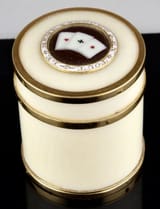Search Results
ID: B6rj8/kw/qst/6216391#6218199
3/26/2025, 5:30:08 AM
As Reference:
Wand of Head Knocking, 2nd Degree. Unstable. School of Kinesiology. Targets known living organisms with brains, causing the brain of the target to vibrate violently, causing concussions, disorientation, nausea, and potentially unconsciousness or even death. Can be blocked by lead. LIMITATION: The tip of the wand must be in an unobstructed line to head of the target. Range is up to six yards with casting, up to twelve with overcasting. Catalyzed with eighth-charge of salt with casting, or a fourth-charge with overcasting. Fueled with eighth-charge of an ounce-nodule with casting, or a forth of an ounce-nodule with overcasting. Some Strangeness produced on caster and on fuel source with casting, Strangeness in the Second Degree produced on both with overcasting. One-in-one-hundred chance for some Strangeness produced on target with casting, one-in-five chance for some Strangeness with overcasting. Base DC 5 for hammer cast. Base DC 10 for hammer overcast. Base DC (2+1pC) for each standard cast of a chained casting. Base DC (4+2pC) for each overcast of a chained casting. LIMITATION: Chained casts of Head Knocking, Second Degree do not have cheaper casting costs. LIMITATION: Chained casts of Head-Knocking can target up to three separate targets with seven total separate casts – any more than this requires a second action. Hammer casts and overcasts of Head Knocking has a nineteen-in-twenty chance to completely knock the target out cold for thirty seconds or so, and each chained cast or overcast of Head knocking has a thirteen-in-twenty chance to completely knock the target out cold for twenty seconds. The duration of unconsciousness stacks with subsequent successful casts of Head Knocking that also manage to fully knock out the target. Each successful cast of Head Knocking has a one-in-two-hundred-and-fifty-six chance to kill the target, determined independently from the target getting completely knocked out. For every subsequent successful cast of Head Knocking on a target that is currently concussed, the odds of outright killing the target are doubled, and then run again. Example: Chlotsuintha performs seven standard casts of Head Knocking, in a chained cast, all at one target, with no bonuses or maluses effecting her cast. She rolls seven d100 dice each with a DC of 9. She succeeds at six of them, meaning that the spell reached completion six times, and that the target has become concussed. She rolls six d100 dice with a DC of 2 to determine if any Strangeness is produced on the target. She succeeds at all of them, meaning that no Strangeness is produced on the target, though Strangeness is produced on herself and on the wand’s fuel nodule. She rolls six d20 dice with a DC of 8. She succeeds four times, meaning that the target is out cold for eighty seconds. Then the QM rolls one d256 die, one d128 die, one d64 die, one d32 die, one d16 die, one d8 die and one d4 die, all with DCs of 2. Two of the tests fail, target dies.
Wand of Head Knocking, 2nd Degree. Unstable. School of Kinesiology. Targets known living organisms with brains, causing the brain of the target to vibrate violently, causing concussions, disorientation, nausea, and potentially unconsciousness or even death. Can be blocked by lead. LIMITATION: The tip of the wand must be in an unobstructed line to head of the target. Range is up to six yards with casting, up to twelve with overcasting. Catalyzed with eighth-charge of salt with casting, or a fourth-charge with overcasting. Fueled with eighth-charge of an ounce-nodule with casting, or a forth of an ounce-nodule with overcasting. Some Strangeness produced on caster and on fuel source with casting, Strangeness in the Second Degree produced on both with overcasting. One-in-one-hundred chance for some Strangeness produced on target with casting, one-in-five chance for some Strangeness with overcasting. Base DC 5 for hammer cast. Base DC 10 for hammer overcast. Base DC (2+1pC) for each standard cast of a chained casting. Base DC (4+2pC) for each overcast of a chained casting. LIMITATION: Chained casts of Head Knocking, Second Degree do not have cheaper casting costs. LIMITATION: Chained casts of Head-Knocking can target up to three separate targets with seven total separate casts – any more than this requires a second action. Hammer casts and overcasts of Head Knocking has a nineteen-in-twenty chance to completely knock the target out cold for thirty seconds or so, and each chained cast or overcast of Head knocking has a thirteen-in-twenty chance to completely knock the target out cold for twenty seconds. The duration of unconsciousness stacks with subsequent successful casts of Head Knocking that also manage to fully knock out the target. Each successful cast of Head Knocking has a one-in-two-hundred-and-fifty-six chance to kill the target, determined independently from the target getting completely knocked out. For every subsequent successful cast of Head Knocking on a target that is currently concussed, the odds of outright killing the target are doubled, and then run again. Example: Chlotsuintha performs seven standard casts of Head Knocking, in a chained cast, all at one target, with no bonuses or maluses effecting her cast. She rolls seven d100 dice each with a DC of 9. She succeeds at six of them, meaning that the spell reached completion six times, and that the target has become concussed. She rolls six d100 dice with a DC of 2 to determine if any Strangeness is produced on the target. She succeeds at all of them, meaning that no Strangeness is produced on the target, though Strangeness is produced on herself and on the wand’s fuel nodule. She rolls six d20 dice with a DC of 8. She succeeds four times, meaning that the target is out cold for eighty seconds. Then the QM rolls one d256 die, one d128 die, one d64 die, one d32 die, one d16 die, one d8 die and one d4 die, all with DCs of 2. Two of the tests fail, target dies.
Page 1
